Thrips on Plants: Effective Ways to Get Rid of Thrips
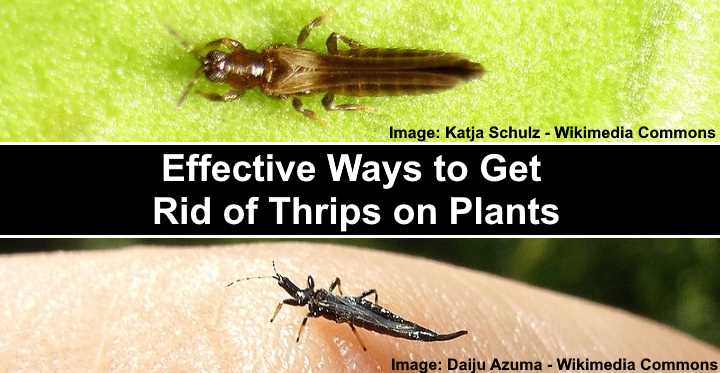
Thrips are tiny, winged insects that do tremendous damage to plants. These common pests feed on the sap and juices of houseplants, garden plants, and greenhouse crops. Thrip infestations can damage plants so much that leaves lose color, and plants eventually die. Thrips are challenging to get rid of. Their pupae lurk in the soil before emerging to feed on plants.
Unfortunately, if you discover thrips living on your houseplant leaves’ underside, the infestation is already extensive. Thrips damage plants by piercing and sucking sap from the stems and leaves. Female thrips also lay eggs in leaves, making them difficult to eradicate.
In this article, you’ll find out the most effective ways to eliminate thrips from plants. In addition to using natural insecticides, it’s vital to know the life cycle of thrips to prevent them from returning.
What are Thrips?
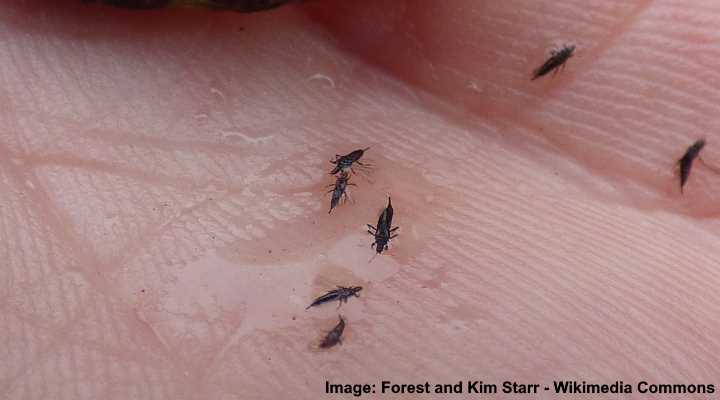
Thrips are tiny insects that include numerous species and can cause extensive damage to plants
Thrips are minuscule black, yellow, or tan winged insects in the order Thysanoptera. There are over 6,000 species of thrips. Although there are some beneficial species of thrips, most of them are plant-destroying creatures. Most thrips measure about 1 – 2 mm long, making them difficult to spot.
Other names for thrips include thunderbugs, thunderblights, corn lice, and corn flies.
Thrips Plant Damage
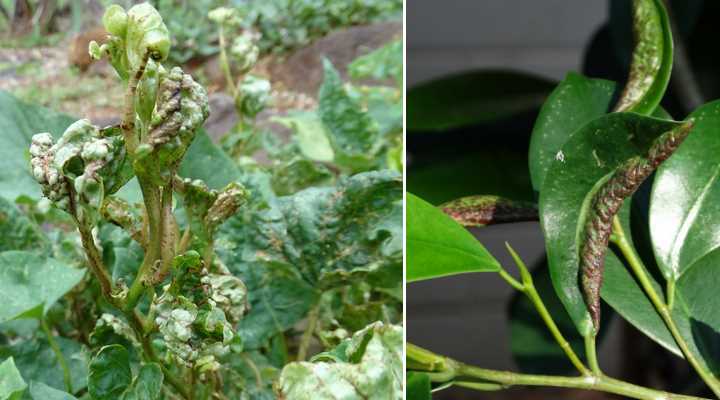
Pictures of leaf damage caused by thrips
Thrips damage plants when feeding on the leaves and stems. Thrips have mouthparts that pierce soft plant tissue so they can suck plant juices. Thrips damage to plants looks like silvery-white spots and black dots. If you don’t get rid of thrips fast, plant damage can cause leaves to become discolored and lead to eventual death.
There’s another way how thrips damage plants. Thrips damage plants by spreading severe plant diseases. Thrips can infect plants with impatiens necrotic spot virus and tomato spotted wilt virus. Both plant diseases cause wilting or stunted growth, leaf spot, and death of the plant. Thrip-borne plant diseases can affect greenhouse plants, garden plants, and houseplants.
Thrips can damage roses, tomato plants, ornamental plants, monstera houseplants, orchids, fruit trees, and vegetables. Usually, insects in the family Thripidae cause the most damage to plants.
What do Thrips Look Like?
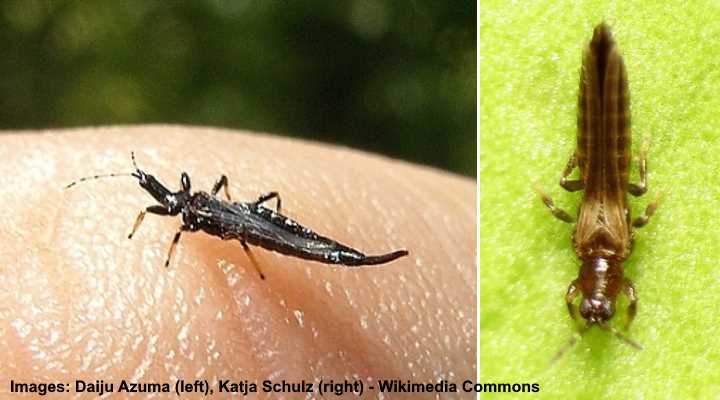
Close up images of thrips
Thrips have long, slender bodies and are usually black, yellow, or light brown. These sucking insects have fringed wings and will usually fly away or jump when disturbed. Thrips range in size from 0.02” to 0.55” (0.5 to 14 mm). However, the types of thrips that infest houseplants are usually 0.04” (1 mm) long.
Because of their minute size, thrips are incredibly challenging to spot. The nasty creatures can look like tiny black slivers lurking under leaves. Under a microscope, thrips resemble minuscule lobsters, and they may or may not have wings. Usually, thrip plant damage is more noticeable than the insects.
The best way to find if your plant has thrips is to put a white piece of paper under the plant’s leaves. Then tap the leaves firmly. Any nasty bugs lurking under the leaves will fall on the white paper.
Related reading: How to identify the most common houseplant pests.
Where to Find Thrips on Plants
Thrips typically reside on the underside of leaves, where they also lay their eggs. At first, a thrip infestation may look like tiny black, white, or yellow dots. Sometimes, you may see thrips crawling on the underside of leaves or flying around the foliage.
Although thrip eggs in leaves don’t damage the plant, they are only signs of more significant problems ahead. After hatching, the pupae drop into the soil where they develop into adults. So, even though you may think that you’ve got rid of thrips for good, you may discover a ‘new’ infestation after a few days.
What are the Signs of Thrips Infestation?
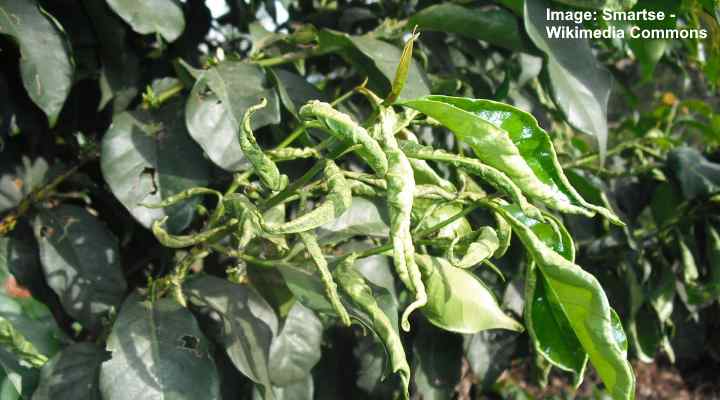
Curling leaves are one of the signs of thrips damage to plants
Thrips infestations usually appear first as small dark green or black specks on the underside of leaves. In time, the tiny spots become silvery before larger discolored stains start to appear. As the plant growth weakens, leaves may wither, become yellow, and begin to curl at the edges.
Depending on the species of plant, leaves may develop sunken, discolored streaks. If thrips have been feeding on buds, you may notice that they don’t develop into flowers. In severe cases, you may see that heavily infested plants stop growing.
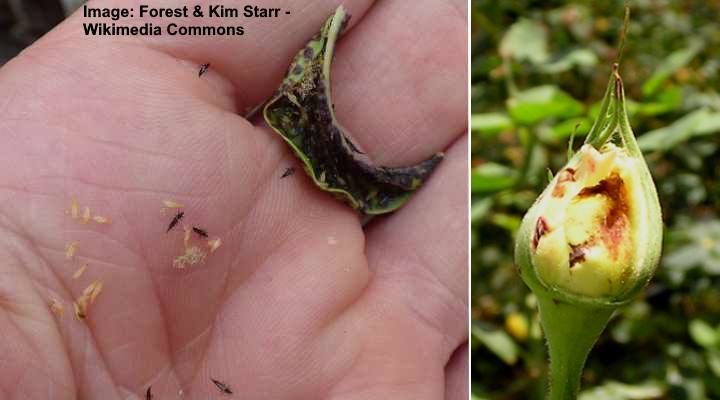
Close-up picture of thrips damage: black leaf discoloration (left picture) and rose bud damage (right picture)
Another sign of a thrip infestation is galls on the leaves or stems. These look like small discolored raised bumps that make the plant look unattractive. When thrips lay their eggs in leaves, galls form, which then excrete a chemical that damages cells. In time, the damaged cells multiply, and you’re left with leaf galls.
Thrips Life Cycle
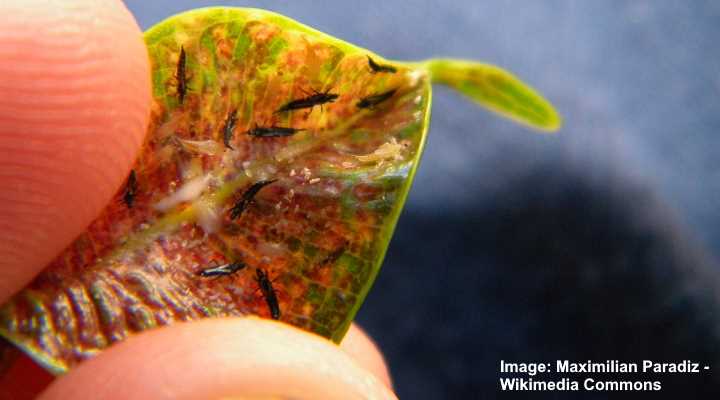
Thrip eggs, larvae and adults on a leaf
Thrips live for about 45 days. As with other insects, thrips start as tiny cylindrical eggs buried in the plant’s soft tissue. The eggs hatch and thrips go through two larval stages before becoming pupae. Then, the pupae drop to the soil and develop into adult pests. In warm weather, the thrip’s lifecycle from egg to adult can take as little as 14 days.

Larvae and adult thrips
To successfully eradicate all thrips from your plants, it’s vital to know the lifecycle. Vigilance is necessary because even after treating a plant for thrips, there could still be microscopic pupae in the soil. As soon as they hatch, they will start feeding on the plant again. And the life cycle begins all over again.
What do Thrips Eat?
Thrips feed on plant juices by puncturing the leaves with their mouthparts and sucking the liquid. This plant damage can cause discoloration on leaves. Thrips also eat various types of fruits, and their piercing jaws can scar or deform developing fruit. Larvae also feed on the plant leaves after they hatch from eggs.
Should You Use Pesticides to Get Rid of Thrips?
It’s usually best to use non-toxic pest control methods to get rid of thrips. Many types of pesticides are poisonous to humans and pets and require special care when handling. Also, houseplant bugs and thrips can become resistant to synthetic chemical insecticides. Although they are challenging to exterminate, thrips can be controlled with many effective natural remedies.
Of course, when you find bugs and insects such as thrips on houseplants, it can be tempting to use chemical pesticides. They may seem like a quick solution to your houseplant pest situation. However, there are many effective ways of getting rid of thrips using non-toxic methods.
Related reading: Natural ways to get rid of common houseplant bugs.
How to Get Rid of Thrips
Before using any natural method to eradicate thrips from houseplants, you need to try and physically remove them from the plant. For houseplants, take the plant to the shower or outside and hose down the foliage. If you have a thrip infestation in the greenhouse or garden, turn the hose on the foliage to remove as many thrips as possible.
Let’s look at some of the most effective ways to eliminate thrips from your plants.
Insecticidal Soap to Eliminate Thrips
Insecticidal soap is an excellent way to get rid of thrips from houseplants. Mix 1 or 2 tbsp. of liquid Castile soap in a gallon (4 l) of distilled warm water. Pour the mixture into a spray bottle and liberally douse both sides of the leaves to help kill off the thrips. Alternatively, you can buy a commercial insecticidal soap to treat your houseplants. Use once a week for the best results.
It’s good to remember that for insecticidal soap to be an effective weapon against thrips, you need to apply it regularly.
According to researchers, insecticidal soaps are non-toxic to people, animals, and birds. The soap works on pests like thrips by breaking down the outer layer of their body. Insecticidal soap can be used for killing thrips, whitefly, spider mites, and aphids.
In homemade bug control sprays for thrips and other insects, it’s best not to use liquid dishwashing detergent. Soaps are made from fats and oils and have an insecticidal action. Also, soap leaves a film on the leaves, which is essential for natural pest control.
Insecticidal soap is also an effective way to get rid of mealybugs, spider mites, aphids, and other plant bugs.
Get Rid of Thrips with Neem Oil
Neem oil is a natural insecticide that can help get rid of thrips and disrupt their lifecycle. Mix 2 tsp. neem oil with 1 tsp. liquid Castile soap and combine in a quart (1 l) spray bottle filled with warm water. Use the bug spray to coat all the leaves to get rid of your thrip invasion. There are also commercial neem oil sprays that can be just as effective in getting rid of thrips.
There is some scientific research on the efficacy of neem oil in eradicating thrips. Scientists found that a 2% neem oil application resulted in a 60% reduction of thrips after the second application.
Spinosad Helps Kill Thrips Naturally
Spinosad is a natural substance that causes thrip mortality and can help you wipe out the pests from your home naturally. Spinosad kills thrips by affecting their nervous system, paralyzing them, and then killing them. Many natural and organic pesticide products contain Spinosad to eliminate thrips, spider mites, ants, and leafminers.
The National Pesticide Information Center (NPIC) says that Spinosad is a natural substance from a soil bacterium. The chemical composition is toxic to bugs and insects but breaks down quickly in the environment.
Researchers say that Spinosad gets absorbed into the leaf structure—ideal for killing off thrip eggs. Some people also add horticultural oil to the spray to make it more effective. However, it’s important to note that Spinosad can also be toxic to beneficial insects and pollinators. So, it’s best not to use it on flowering plants.
Use Dormant Oil to Eradicate Thrips
Also called horticultural oil, you can use dormant oil sprays to get rid of a thrip infestation. Dormant oil works on thrips and other insects by suffocating and killing them. Also, the oil sprays can affect the larvae and egg metabolism, interrupting the thrip lifecycle.
To make your own bug spray to kill off thrips, mix one cup of sunflower oil with half a cup of liquid dish soap or Castile soap in a jar. Close the lid and shake vigorously until the solution becomes white.
To apply dormant oil to destroy thrips, mix one tablespoon of the dormant oil solution to a quart (1 l) of warm water. Mix well and spray liberally on your plant foliage once a week to eliminate a thrip infestation.
Like all natural thrip control methods, you need to apply dormant oil regularly so that it’s effective. Also, dormant oil can kill beneficial insects, so only use it when you really have to.
Yellow Sticky Traps for Controlling Thrips
Use yellow sticky traps to help reduce the thrip population. Thrips are attracted to yellow colors, and the pesky thrips will stick to the traps. Yellow sticky traps can also help you monitor thrips to determine the size of the infestation.
However, it’s vital to remember that sticky traps are just one weapon in the battle against thrips. So, continue to use neem oil sprays or insecticidal soap sprays along with the sticky traps.
Kill Thrips by Introducing Beneficial Insects
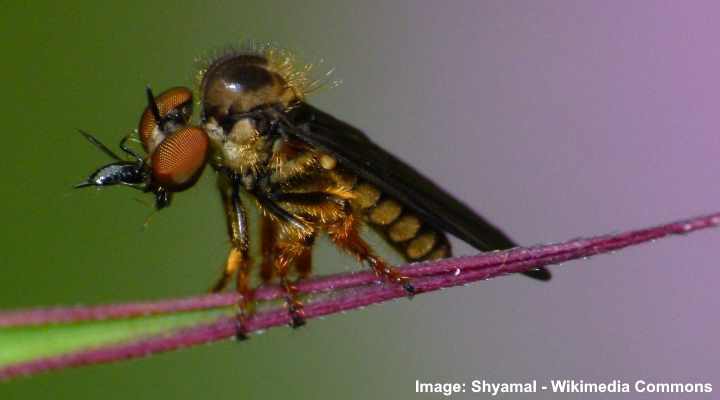
A robber fly preying on a thrip
If you’ve got an infestation of thrips in a greenhouse or garden, you could release beneficial predatory insects. For example, ladybugs, lacewings, and minute pirate bugs feed on thrips and their eggs and larvae.
You could also grow plants that attract ladybugs and other insects that feed on thrips. Some plants to attract thrip predators include fennel, dill, carpet bugleweed, marigolds, spearmint, spike speedwell, and stonecrops.
Pruning Can Help Get Rid of Thrips
Cut off infected leaves to remove thrips from your plants. If you only have a few leaves with signs of a thrip infestation, then prune them off and destroy them to get rid of thrips. For garden plants, prune off any galled and rolled leaves in winter to destroy the thrip eggs.
How to Prevent Thrips
It’s easier to prevent thrips rather than trying to get rid of them. The lifecycle of these irritating pests means that they can suddenly reappear just when you think you’ve eliminated them for good.
Inspect New Plants to Prevent Thrips in Your Home. Before bringing any new plants home, thoroughly inspect them for signs of thrips. If you notice spotting on the leaf undersides or discolored leaves, don’t buy the plant. Even if you think the plant has no pest problems, it’s best to quarantine plants for two weeks just to make sure.
Regularly Check Plants for Thrips. Nipping a thrip infestation in the bud is the best way to prevent a massive thrip invasion. It’s best to be in the habit of regularly checking houseplant foliage for signs of thrips. If you see dark green dots on leaves’ underside, isolate the plant immediately from your other houseplants.
Then treat the infested plant with an organic neem oil solution. At the same time, you could place yellow sticky traps near your other plants to monitor the thrip infestation.
Related articles:
- Effective Ways to Kill Aphids on Plants
- How to Kill Scale Bugs (Scale Insects)
- Effective Ways to Kill Spider Mites on Plants
- How to Kill Whiteflies on Plants
